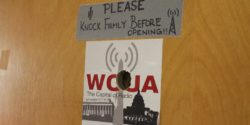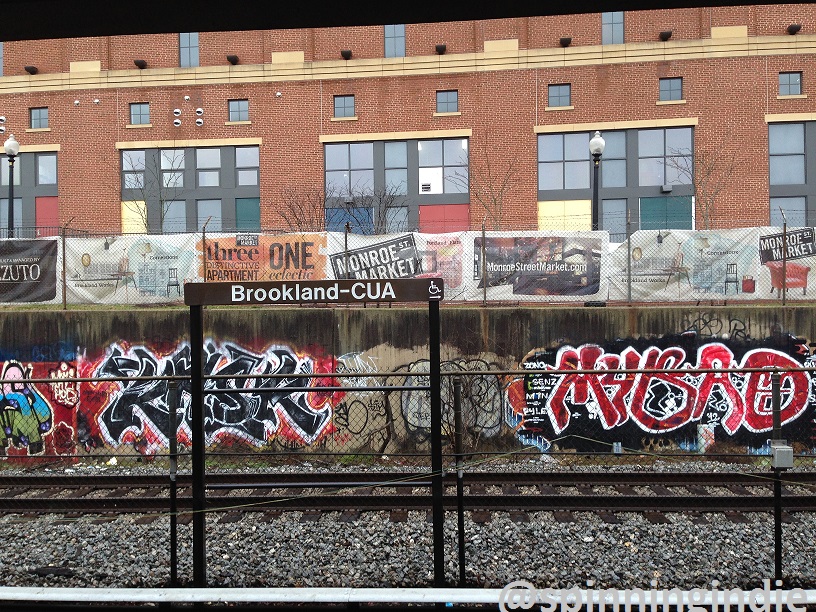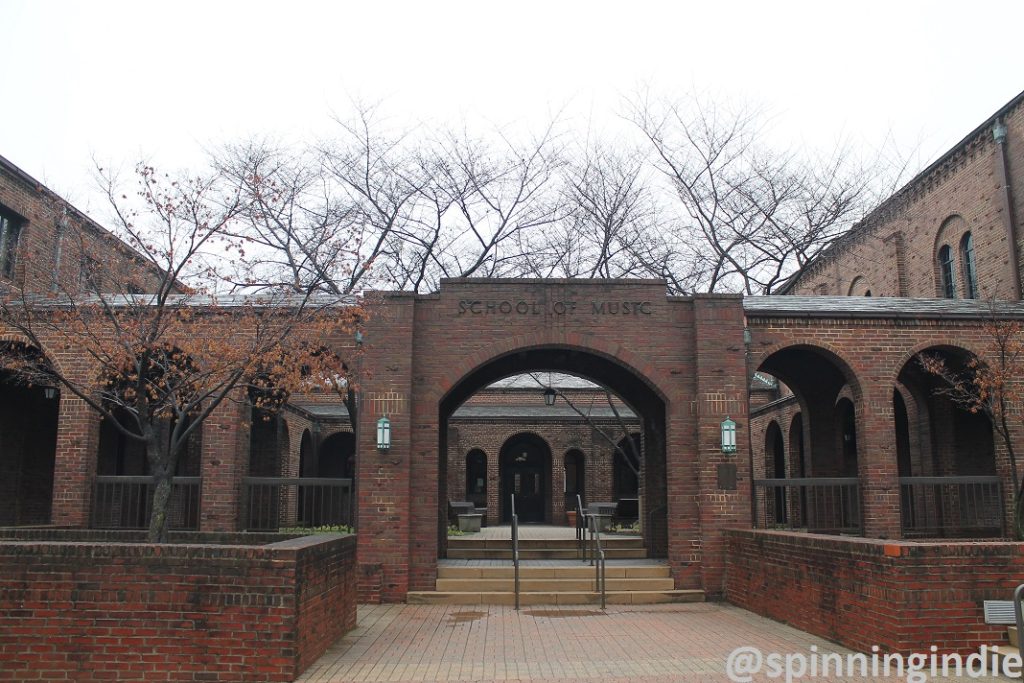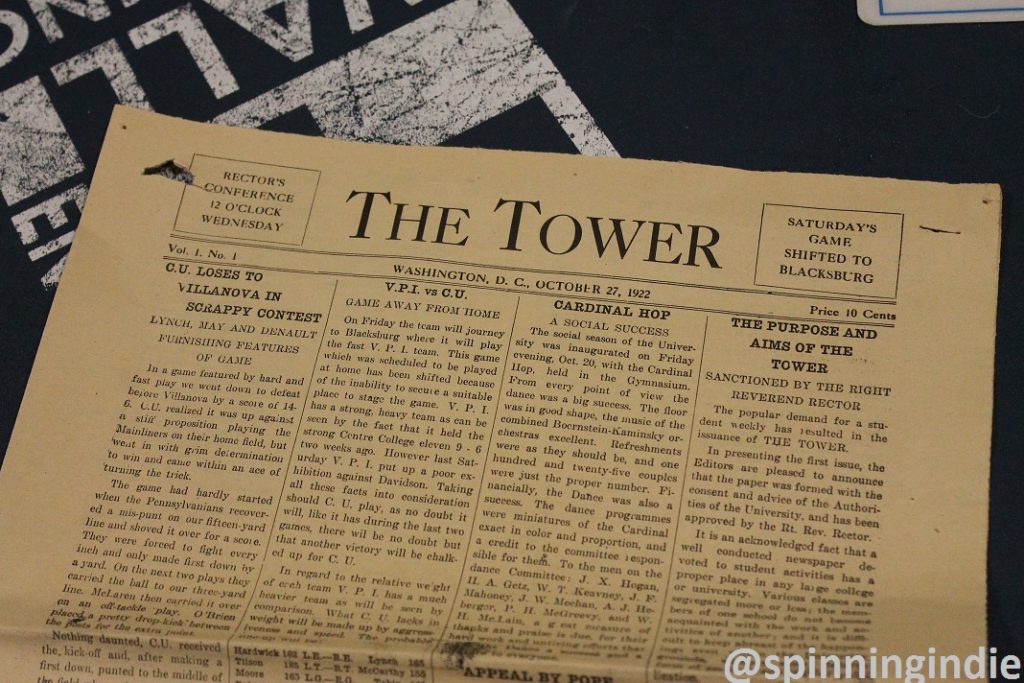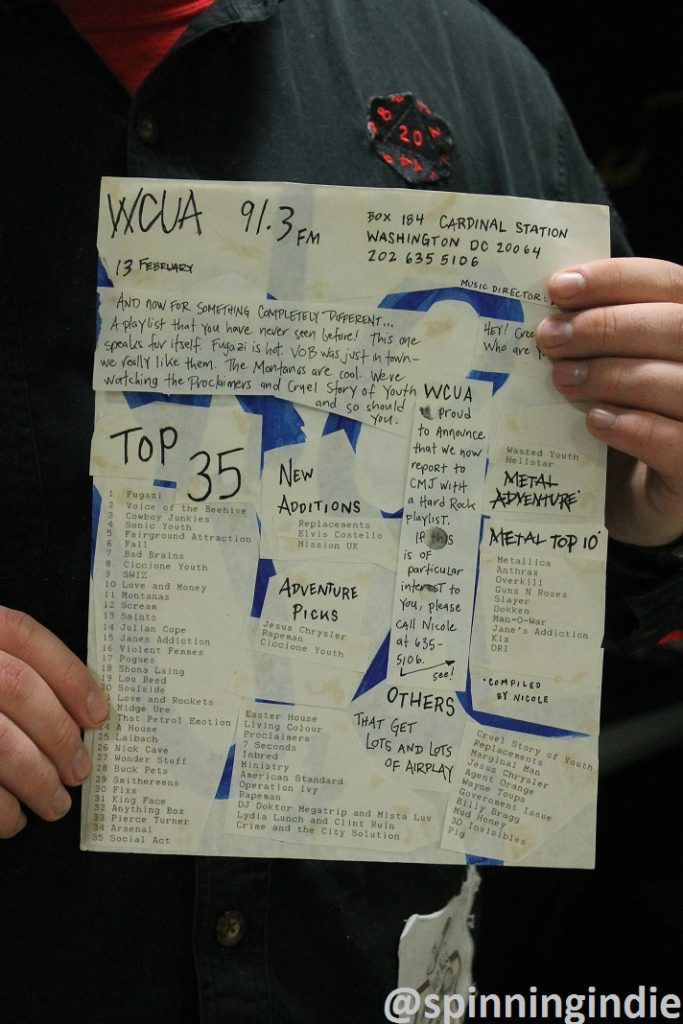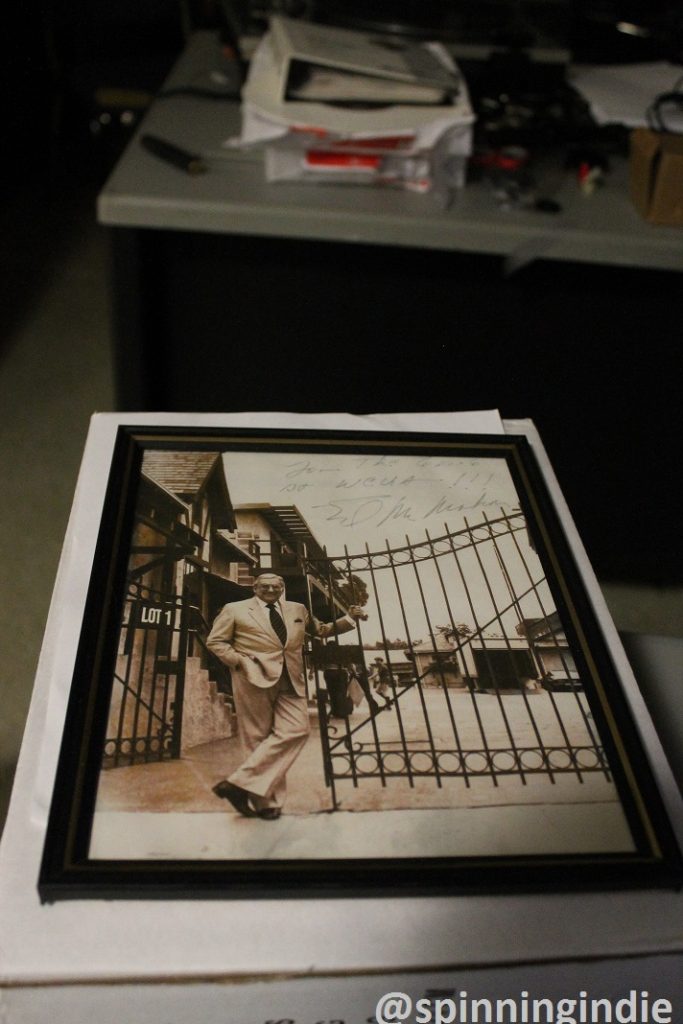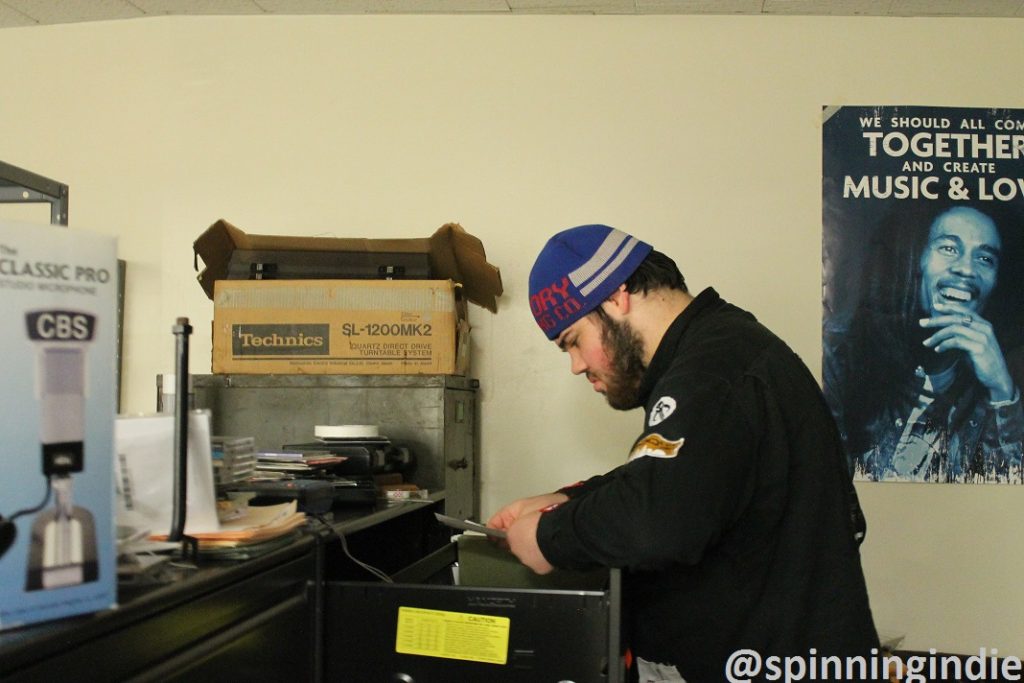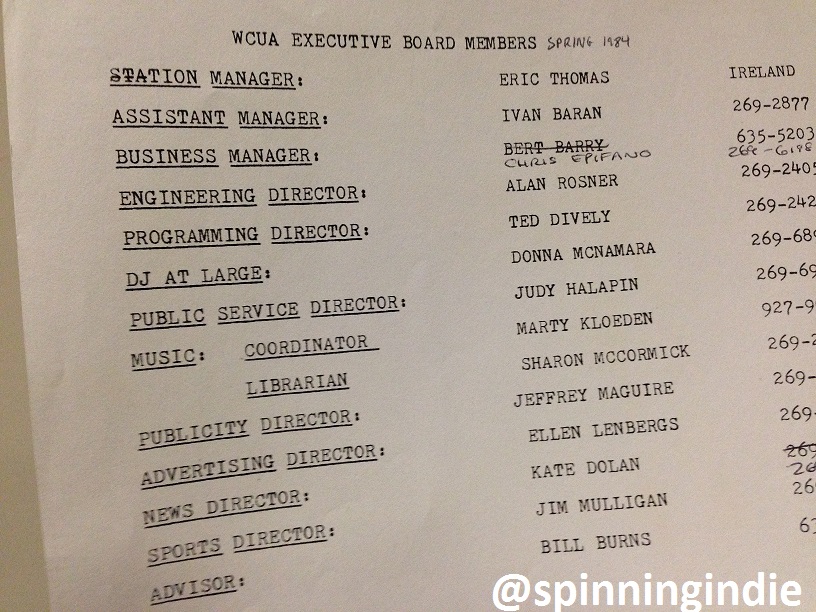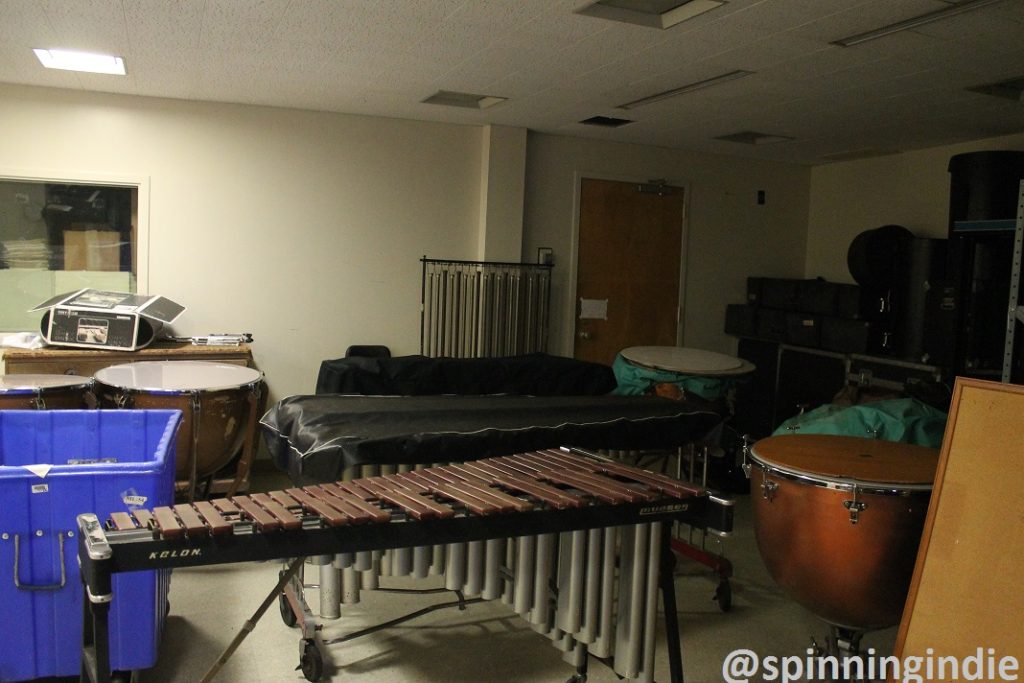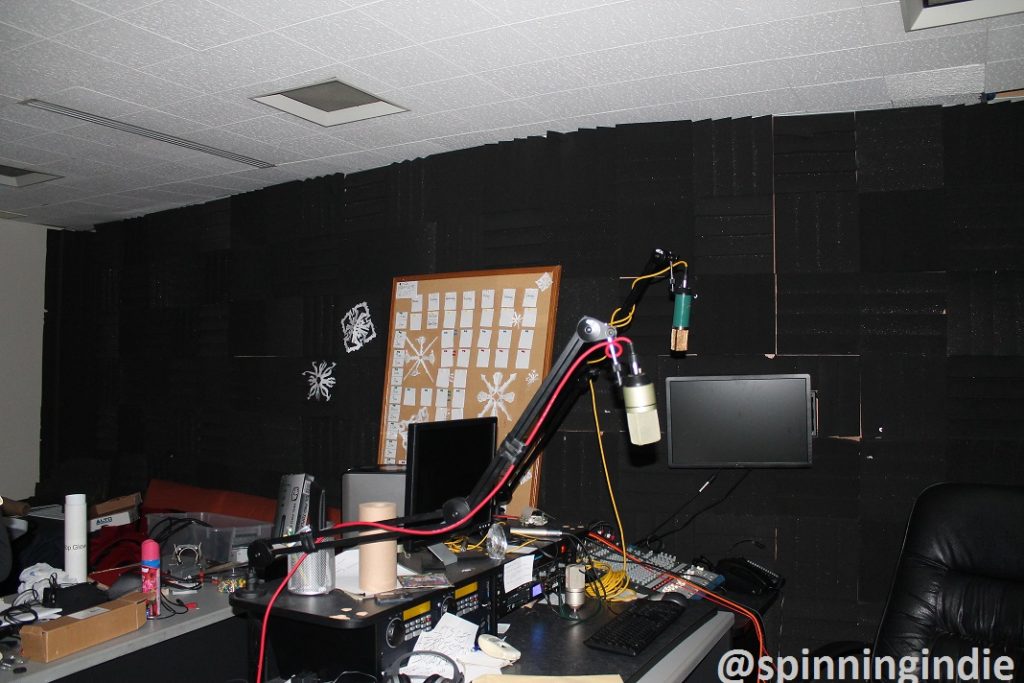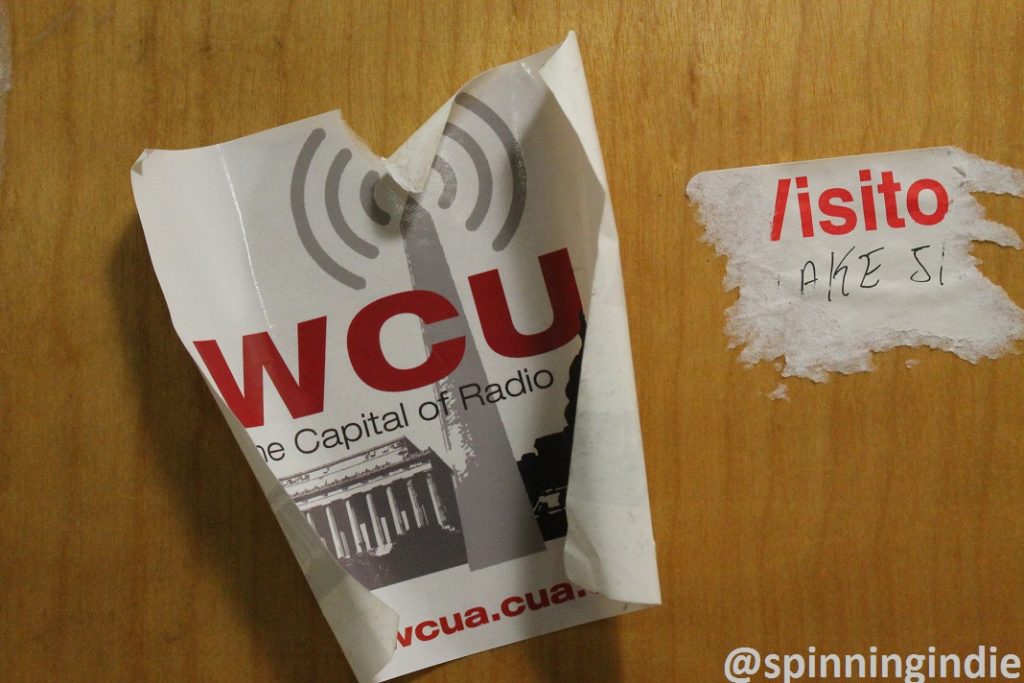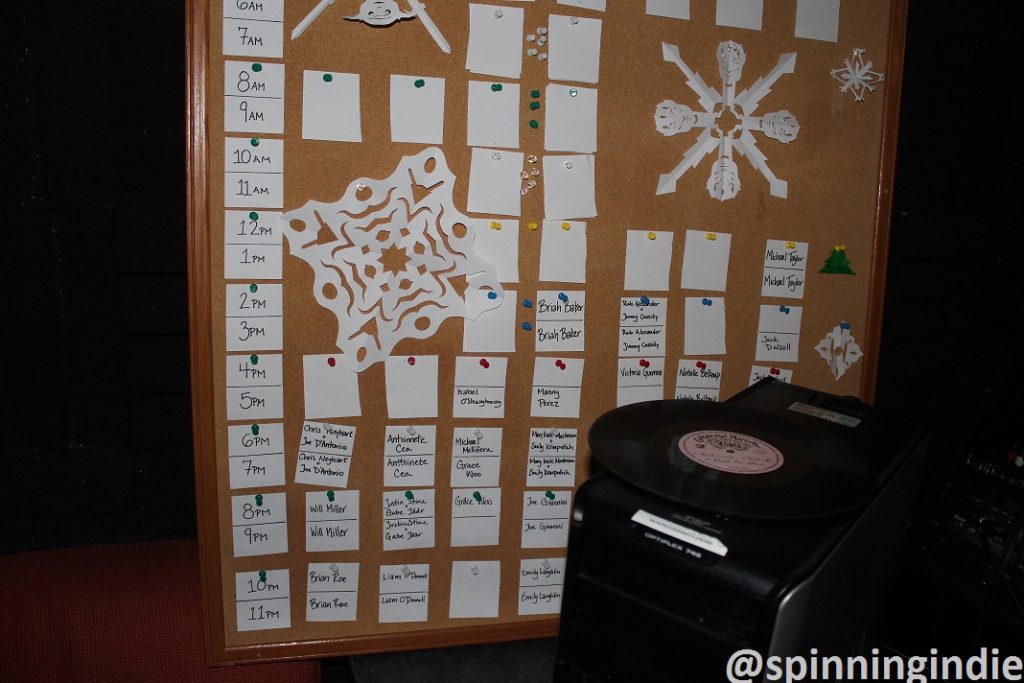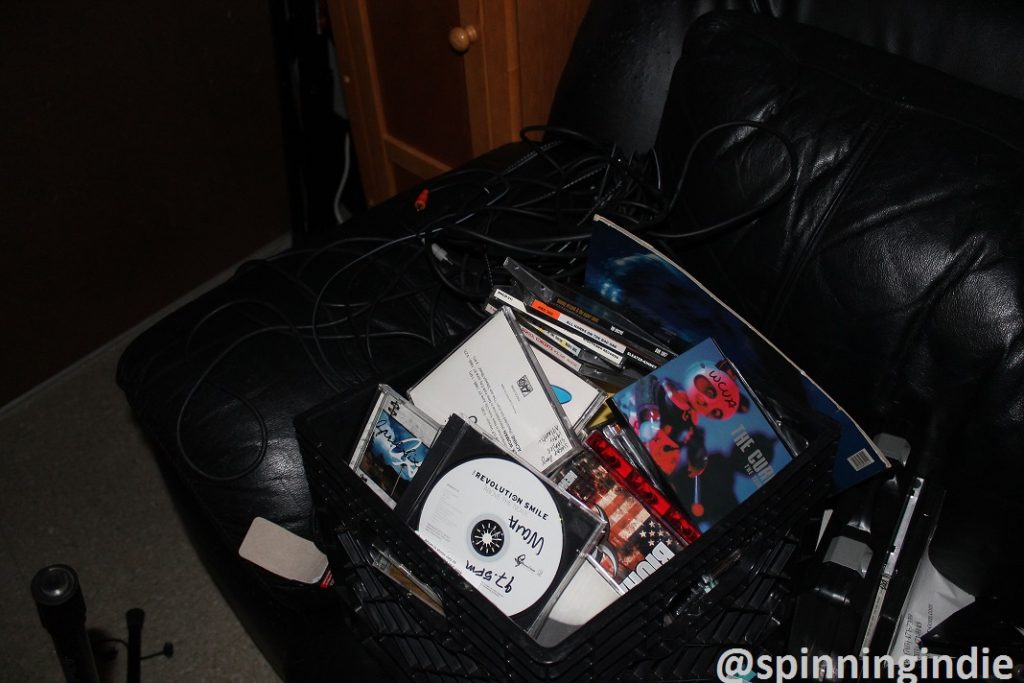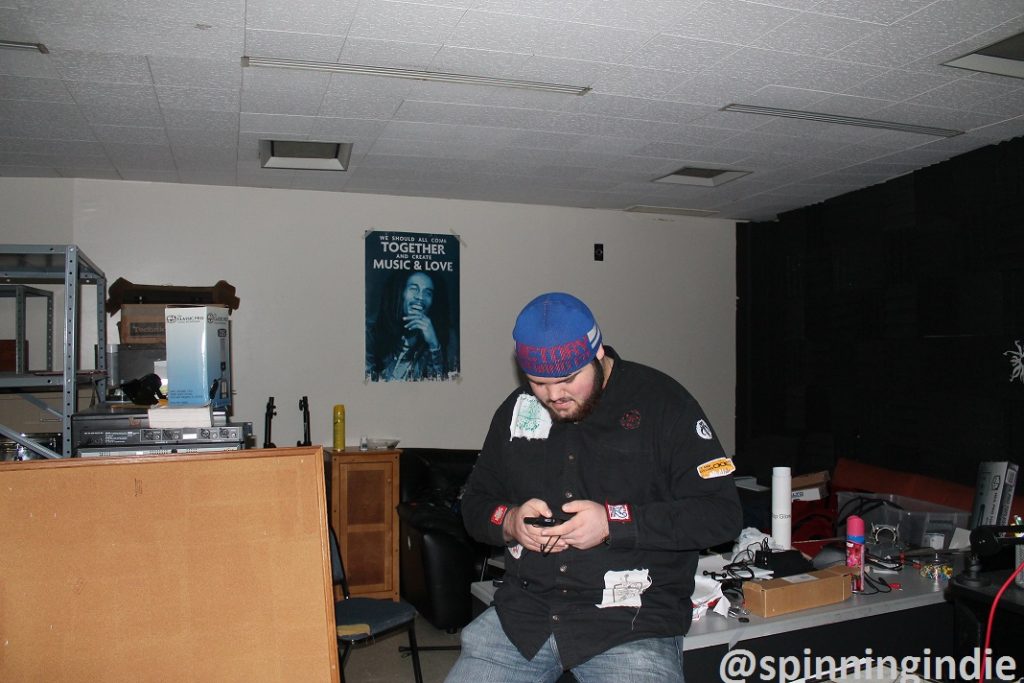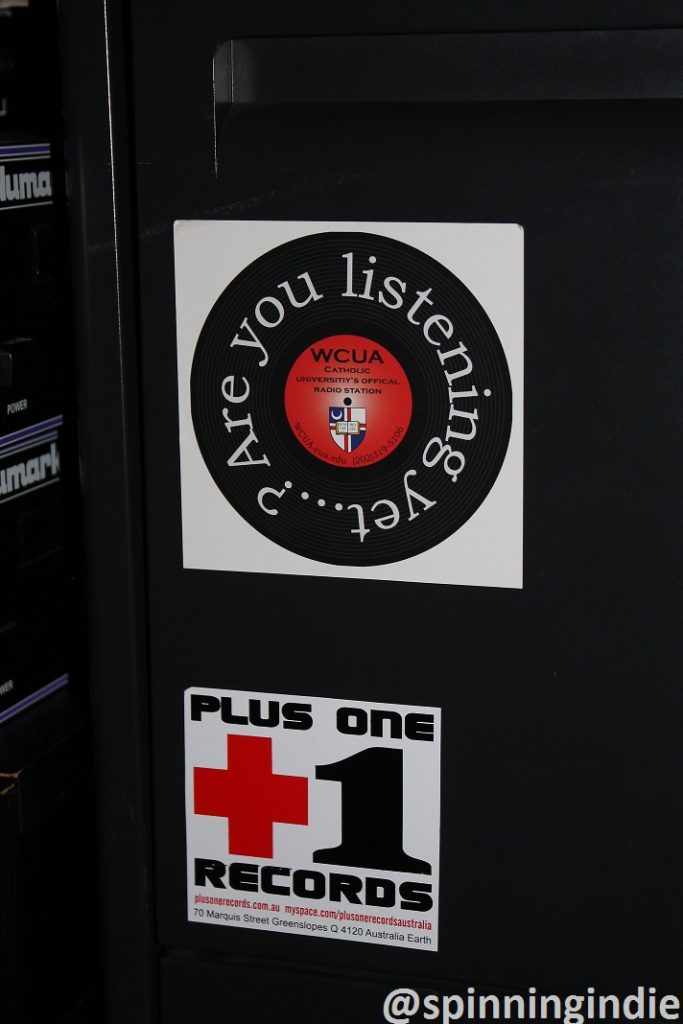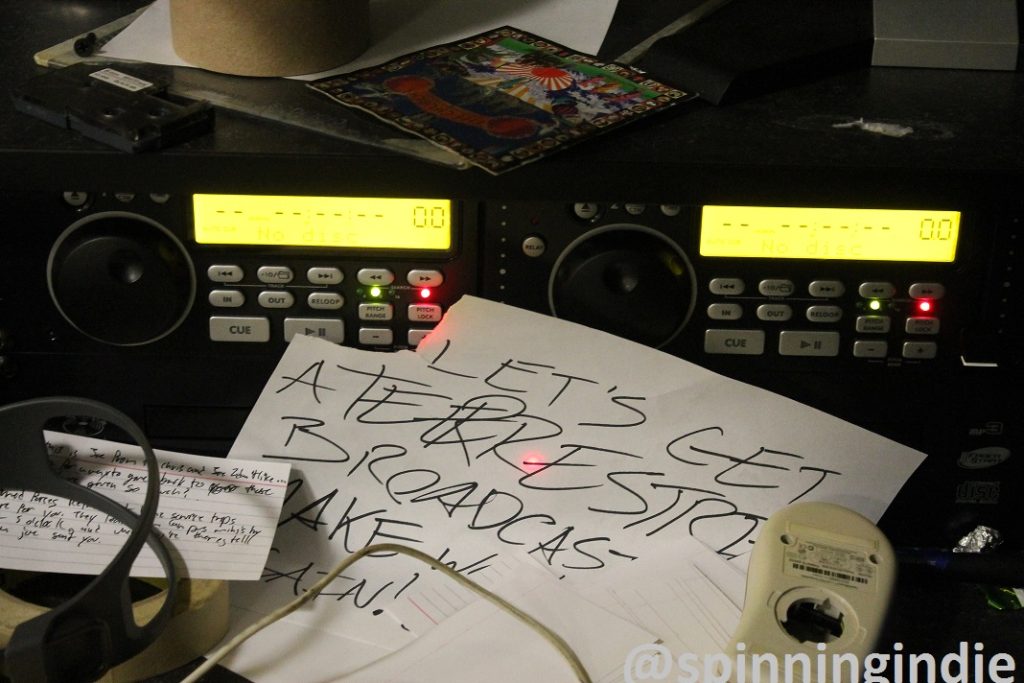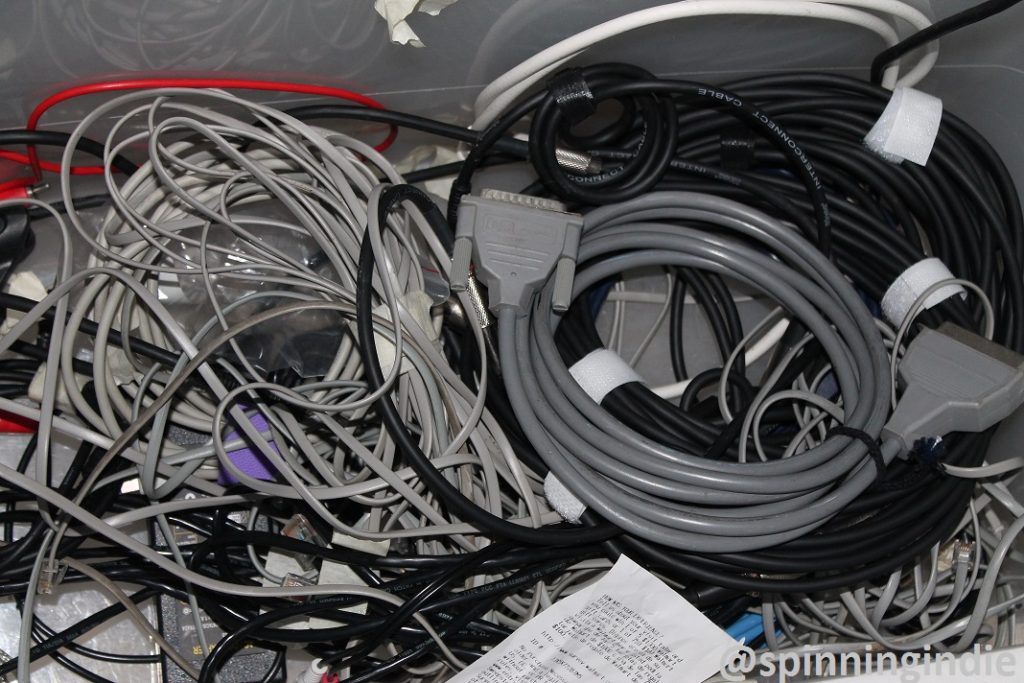The next stop on my radio journey is to college radio station WCUA at Catholic University of America in Washington, D.C. After arriving in D.C. on Wednesday, February 24, 2016, I took the Metro to the university’s stop at Brookland.
Rain was in the forecast, but I enjoyed my walk to the edge of campus in order to visit the station’s basement home in Ward Hall in the Benjamin T. Rome School of Music building. WCUA Station Manager Joe D’Antonio met up with me and filled me in on how he and his friends revived the station.
An online-only station today, WCUA is the descendant of a long radio legacy at Catholic University. According to S.E. Frost in Education’s Own Stations, an experimental radio transmitter was built in 1921 by the Department of Electrical Engineering. A broadcast license was acquired in February, 1923, with call letters WQAW and “Broadcasting was begun immediately, the programs consisting of phonograph records, occasional ‘live’ talent, talks, and discussions,” Frost writes. This station was short-lived. Frost explains that, “…with the growth of commercial broadcasting, the University authorities felt that station WQAW was ‘hopelessly outclassed.’ To furnish programs at regular hours and in keeping with the dignity of the University was found to incur so great an expense as to be prohibitive.” The license expired in August, 1923 and its call letters were deleted in June, 1924.
WCUA’s Wikipedia page recounts the many ups and downs of subsequent stations. When the carrier current boom was in full effect in the 1940s, students experimented with dorm-based low power broadcasts. One station, WGIB, started in 1948, but it wasn’t until 1958 that an official campus station WCUA launched, but it faded out in 1962. Radio was revived with WWCU in 1972 and in 1981 the name was changed to WCUA. Over the years the unlicensed station operated on various frequencies on campus, including AM and FM. There’s an amazing photo from the 1980s (and lots of alumni recollections) on the Catholic University Alumni Association’s Facebook page.
D’Antonio didn’t know much about the station’s history, telling me that it was “shrouded in mystery,” but that said that radio has had a “long and storied tradition” on campus. He showed me a signed Ed McMahon photo and told me there were rumors that the actor had gotten his start at the station (he graduated from Catholic University in 1949). D’Antonio explained the scarcity of information, saying, “We know he was here and we know that he signed an autograph.”
Flash forward a few decades and there is also lore that Nirvana once played at the station. D’Antonio tried to find a recording and came up empty, telling me, “we really don’t know.” He added that in a way he likes having these station mysteries, saying that it may be better to not know the actual truth. I asked if he had any interesting historical materials and D’Antonio starting pulling paperwork out of file cabinets for me.
Within the archives were program guides, meeting minutes, station management election results and other ephemera from the 1980s and 1990s. I was shocked to see the familiar name of former KUSF DJ Ted Dively and confirmed later that he indeed got his college radio start at WCUA. The station also has a collection of older music, including sound effects and metal CDs. D’Antonio joked, “We’re pretty sure that in the ’90s the station got taken over by metalheads.”
Today, the streaming station occupies a shared basement space with the percussion department. The outside of the station sports a broken “Recording Sign” and there’s a peeling WCUA sticker on the back of the door. Within the dimly-lit room (most of the lights are broken), drums, harps, xylophones, and other instruments fill one side; while WCUA equipment and materials fill the other. Metal file cabinets form a bit of a dividing line and a couple of couches reside at the back of the station’s section. D’Antonio spoke of the shared tenant, saying, “every so often there will be someone down here practicing marimba.” During my visit I heard piano sounds emanating through the walls and D’Antonio told me, “people practice all hours of the day,” but that soundproofing keeps the noise from permeating into the station’s stream.
The darkness of the room made it feel even more mysterious and I found myself asking for more details about what I was struggling to see. Most of the station’s audio equipment is on one table near the entrance to the room. A mixing board, microphones, CD players, computer keyboard, monitors and headphones were part of the set up and some additional equipment, including a broken turntable were on another nearby table. The station also has its own musical keyboard, which one DJ even plays on the air in a nod to old-time radio dramas.
In his second semester at the station, D’Antonio told me, “I’m always trying to make this station better.” He explained his work in bringing the station back (read more about that in an article from the student newspaper), saying that “the station started losing popularity” and that it was defunct by January, 2015. He expressed interest in reviving WCUA and was able to get back into the station by November, 2015 and had a pretty decent DJ roster by the end of that semester. He explained, “We put up one poster and had one meeting,” telling me that after that first meeting, they already had 15 DJs. Following that, people told their friends and the line-up grew even more.
Since that time, “it’s been growing,” according to D’Antonio. More people on campus seem to be aware of the station and students are “really excited…to hear themselves on the radio,” he explained. At the time of my visit, around 35 students were involved with the station and there were 29 different time slots for shows. DJs at WCUA are generally night owls, with programs scheduled from around 6pm to midnight on weekdays. The earliest show in spring semester started at 12 noon on Sundays. The schedule is largely based on DJ requests and D’Antonio told me that he hoped that they’d fill up the schedule with people eventually doing morning shifts as well.
Programs are generally one to two hours in length and a wide variety of genres are represented on the music shows, including hard rock, pop, psychedelic, metal, hip hop, and EDM (including some live mixes). A number of talk shows were also on the air, including a sports talk show. D’Antonio said, “Musical tastes kind of vary…I like punk. My co-host Chris likes classic rock.” He explained that on their team show, “Chris and Joe Don’t Like Mondays,” each will pull from their own collections of music and he enjoys that mix.
The station currently plays digital music and has its own digital library. Physical music wasn’t being used when I visited, although D’Antonio said that they thought they had the ability to play CDs or vinyl, but had “yet to do it.” It’s purely a practical matter as D’Antonio doesn’t eschew physical music and has a record player and vinyl collection at home. At the moment, they are focusing on the “basics” and D’Antonio said that they are “trying to build a foundation” right now, but that after he graduates, he hopes that they “make the greatest station ever once I’m gone.”
He also explained one of the biggest challenges for college radio stations with ever-changing student populations: institutional memory. When reviving WCUA, “no one knew how to do everything” because instructions weren’t easily available, D’Antonio told me. For that reason, he and his cohorts are working hard to not only train all DJs on every aspect of the station’s operations, but also to write up documentation (his dream is to have a book of instructions, including some on how to bring a dead station back to life) that can be passed down to future staffers.
Although he’s more of a music guy, D’Antonio described his pride in WCUA’s recent stint into sports broadcasting, which started up a few weeks before my visit with coverage of a basketball game. He explained, “I am not a sports person [but] when I think college radio, that’s one of the things I think of…” Another thing that D’Antonio thinks about is a terrestrial signal and he told me that everyone at the station wants to be “on the air” again, saying, “people still listen to radio in the car.” He also shared some of his own terrestrial radio memories with me, and reminisced about listening to NPR in the car and also listening to a variety of stations while on road trips.
A second-generation college radio DJ (his dad was a DJ too), D’Antonio is a huge college radio fan, saying, “It’s an opportunity to do something that you’ll never get to do again” and revealed that at Catholic University, “the best kept secret of the radio station is that anyone can do it.” He said that he hopes WCUA will continue after he’s gone, telling me, “I don’t want it to ever go away again.” He joked that the station is like the WCUA sticker on the station door: “It’s beaten up, it’s all crinkly, but it’s still here.”
Thanks so much to Joe D’Antonio for showing me around WCUA. This is my 101st station tour report (and my 70th college radio station visit) and there are more to come. See my most recent field trips on Radio Survivor and see a full list of my station tour reports on Spinning Indie. 7/26/16 Update: Hear more about this visit on Episode #50 of the Radio Survivor Podcast.

